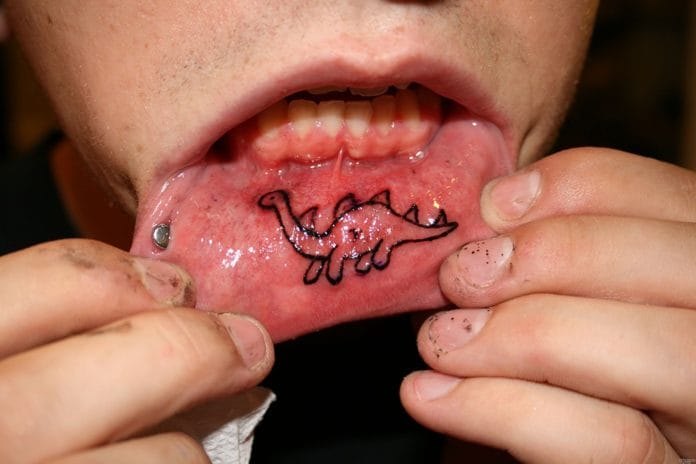Humans have marked their bodies with tattoos for thousands of years, and these permanent designs are always personal, serving as status symbols, signs of religious beliefs, amulets, declarations of love, adornments, and even as forms of punishment. People tattoo every part of their bodies, including their inner labial mucosa, gingiva, and hard palate as a form of self-expression.
Celebrities such as Miley Cyrus may be part of the reason for the increase in this trend after she exposed an inner lip tiger tattoo in 2014. As a clinician, I have personally witnessed these and have a few twenty-something female patients with inner lip tattoos.
Advocates for lip tattoos will boast that they are super trendy, easily hidden, relatively inexpensive ranging from $50-$100, and deeply personal due to where they are located, only shared with those persons they choose to show. Hygienists just get a sneak peek as a result of the oral cancer exams we perform.
Regardless of your stance on lip tattoos, there are some risks with having them that I fear some dental patients might not be aware of when deciding to have this body modification. These include:
- Increased risk of infection due to the oral cavity harboring tons of bacteria in the area of tattoo placement, an alcohol-free mouthwash will be needed after eating and smoking for several days after placement
- Allergic reactions due to red dye that may contain cinnabar known to irritate the oral cavity
- Increased risk of blood-borne diseases such as hepatitis B and C due to possible nonsterile techniques or contaminated ink
- Can be extremely painful, both during and after the procedure
- Only temporary due to the inability of ink to adequately penetrate the mucosal membrane and the quick turnaround of cells in the oral cavity, most only last a few months to five years
- Eating foods with a high acid content such as vinegar, tomatoes, and citrus fruits can cause irritation for a time after the procedure
As you can see, there are plenty of risks and drawbacks to be aware of before making the decision to get inked.
Our patients should also be aware of the credentials and training of the tattoo artist they choose. The requirements to become a licensed tattoo artist vary from state to state. Some states require the completion of an approved tattoo artist training program and successful completion of a written exam, as well as CPR and first aid certification. At this time, no additional courses or training are required to complete intraoral tattoos.
As dental providers, we need to be ready to answer questions in a professional and nonjudgmental manner, providing feedback for our patients who may inquire about getting an intraoral tattoo. Explain the potential risks of the tattoos, the healing process, the extra care required after placement, and make sure patients understand the importance of having very good oral health before receiving the tattoo to prevent the increased risk of infection.
If your patient decides they want the trendy artistic design after all the risks are discussed, remind them to ask about the sterile techniques the parlor uses and to have it done by a state-licensed artist. Always better safe than sorry.
By the way, Joann Fletcher, research fellow in the department of archaeology at the University of York in Britain, dates the discovery of the first tattoo as far back as 5,200 years ago with the discovery of the famous “Iceman” from the area of the Italian/Australian border in 1991.
Before you leave, check out the Today’s RDH self-study CE courses. All courses are peer-reviewed and non-sponsored to focus solely on high-quality education. Click here now.
Listen to the Today’s RDH Dental Hygiene Podcast Below:
References
- Lineberry, C. Tattoos: The Ancient and Mysterious History. Smithsonian. 2007. Retrieved from https://www.smithsonianmag.com/history/tattoos-144038580/
- Pros and Cons of Inner Lip Tattoos. Custom Tattoo Design. Retrieved from https://customtattoodesign.ca/blog/pros-and-cons-of-inner-lip-tattoos/
- Quaranta, A., Napoli, C., Fasano. F., Montagna, C., Caggiano, G., Montagna M.T. Body piercing and tattoos: A survey on young adults’ knowledge of the risks and practices in body art. BMC Public Health. 2011; 11(1). doi:10.1186/1471-2458-11-774.
- The Risk of Lip Tattoos: What You Should Know. United Concordia Dental. Retrieved from https://benefitsbridge.unitedconcordia.com/the-risks-of-lip-tattoos-what-you-should-know/
- How Long Does a Lip Tattoo Last: Inner Lip Ink Longevity. Net Luxury. Retrieved from http://nextluxury.com/mens-style-and-fashion/how-long-does-a-lip-tattoo-last/
- Serup, J., Sepehri, M., Carlsen, K.H. Classification of Tattoo Complications in a Hospital Material of 493 Adverse Events. Dermatology. 2016; 232(6), 668-678. doi:10.1159/000452148.












